Your Cart is Empty
Free Shipping on purchases over $100
|
The cut of a diamond not only refers to the diamond’s shape, it also refers to how effectively the diamond returns light back to the viewer’s eye. A well-cut diamond will appear very brilliant and fiery, while a poorly cut diamond can appear dark and lifeless, regardless of its color or clarity Not only do well-cut diamonds appear more brilliant, they also tend to appear larger than other diamonds of the same carat weight. An "ideal" diamond has both increased brilliance and diameter relative to more deeply-cut diamonds. |
|
Ideal cut diamonds |
|
|
An Ideal Cut Diamond is a round, brilliant, or princess cut diamond that is cut to ideal proportions and angles, and has excellent polish and symmetry ratings. An Ideal Cut Diamond is perfectly proportioned to refract light, producing that fire and brilliance up through to the table and crown. |
|
|
Understanding Brilliance, Dispersion & ScintillationA well-cut diamonds exhibit three different properties: brilliance, dispersion and scintillation. As light strikes a diamond's surface, it will either reflect off the table of a polished stone or enter the diamond. The light that is reflected off the diamond is known as the diamond's brilliance. As light travels through a stone, some of the light rays are separated into flashes of color. This is known as dispersion. The result of dispersion—the separation of white light into its spectral colors— is known as fire. Scintillation is flashes of color that are viewable as an observer moves a diamond back and forth. |
|
It is important to select a diamond that does not have any inclusions that will affect the overall beauty and durability of the diamond. If you want to be 100% sure that your diamond will be completely clean of "eye-visible" inclusions, stick with diamonds graded "VS2" or higher. Shopping for SI quality diamonds can be very rewarding, but it's best to have those diamonds reviewed by Monarch Jewels expert staff before finalizing your order. This will ensure you receive a diamond that does not have any inclusions visible to the naked eye.
It is also a good idea to balance the clarity grade of your diamond with the color. If you are looking at diamonds in the D-F color range, focus on clarity grades of VS2 or higher. Diamonds in the G-I color range combined with SI clarity are excellent values.
Carat is a term that refers to the weight of a diamond. Prior to the twentieth century, diamonds were measured using carob seeds, which were small and uniform and served as a perfect counter weight to the diamond. The word "carob” is the origin of the word "carat" that we use today.
The size of a diamond is proportional to its carat weight. When rough diamonds are cut and polished into finished diamonds, up to 2/3 of the total carat weight may be lost. Since larger rough gems of high quality are found less frequently than smaller rough gems of high quality, a single two carat diamond will be more expensive than two one-carat diamonds of the same quality.
In the United States, the majority of diamonds used in jewelry and sold as loose diamonds are one carat or less in weight. The average engagement ring diamond sold in the U.S. is less than 1/2 carat in weight.
A diamond will increase in weight much faster than it increases in actual "face-up" diameter. For example, while an ideal cut one-carat diamond measures approximately 6.5mm in width, a diamond of twice its weight measures only 8.2mm wide—less than a 30% increase.
This question has no direct answer. It is a choice that depends on personal preference and budget. When looking at a diamond engagement ring, what is most visible is the size of the surface area on the top of the diamond. It is difficult to measure a diamond’s carat weight simply by looking at it. Although carat weight influences cost quite a bit, it is advisable to focus on diamond cut and diameter.
When shopping for a diamond, it is generally preferred to choose a stone with the least amount of color possible. Diamond color is graded on a scale from D-Z and is divided into five broad categories (colorless, near colorless, faint, very light and light). Diamonds come in all colors of the spectrum. The predominant color you see in a diamond is yellow, which is caused by the trace element nitrogen.
Generally, when comparing color between two diamonds, the diamonds need to be at least two color grades apart to even begin to see a difference. As you can see from the images below, when diamonds are in the face up position it is almost impossible to see any color. When viewing the diamond from the side profile, you may start to detect some color; however, diamonds are admired for their beauty from the face up position and not the side.
Diamonds within the colorless range are the most rare and valuable of all those on the color scale. D/E color stones display virtually no color, whereas F colored diamonds will display a nearly undetected amount of color when viewed face down by a gemologist.
 |
 |
 |
| D Color | E Color | F Color |
Diamonds within the near colorless range appear colorless in the face up position, but do display a slight amount of color when viewed face down against a perfectly white background. This trace amount of color will be undetectable to an untrained eye once the diamond has been mounted. Near colorless diamonds offer a tremendous value for their price.
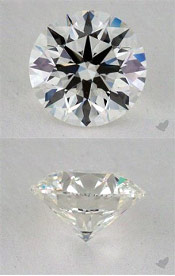 |
 |
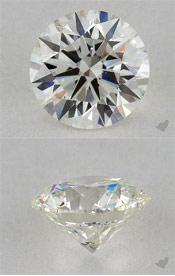 |
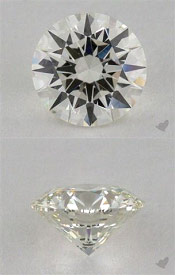 |
| G Color | H Color | I Color | J Color |
Diamonds within the faint color category may show a slight hint color when viewed in the face up position; however, these are another wonderful option for those who are not sensitive to color. Some even love the color scheme that is displayed from these diamonds.
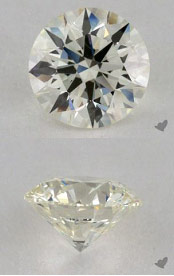 |
| K color |
While the most predominant color found in a diamond is yellow, it’s not uncommon for a diamond to take on a brown color. This is thought to be caused by internal graining, which results from structural irregularities often in combination with an impurity like nitrogen.
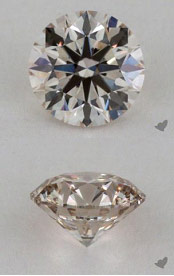 |
 |
 |
 |